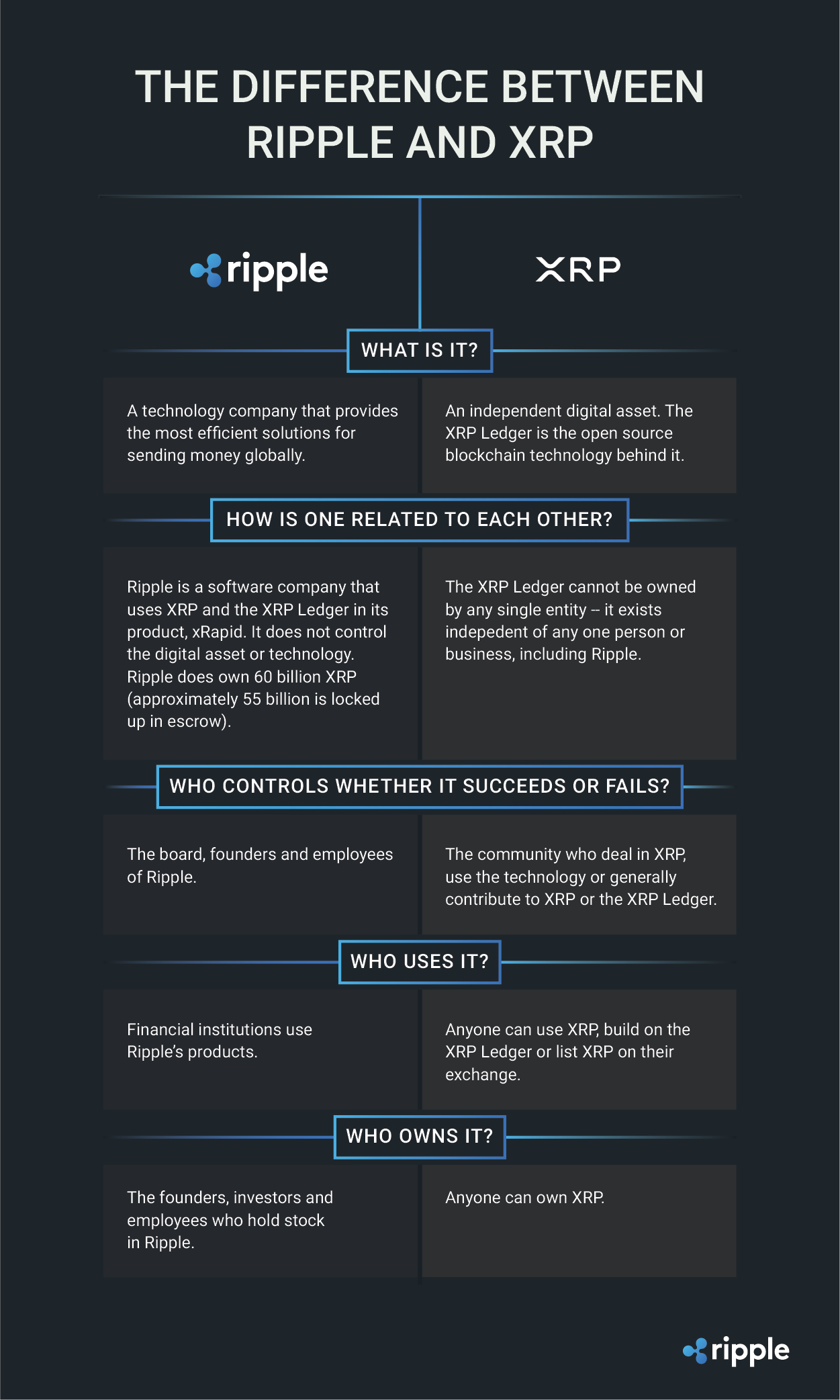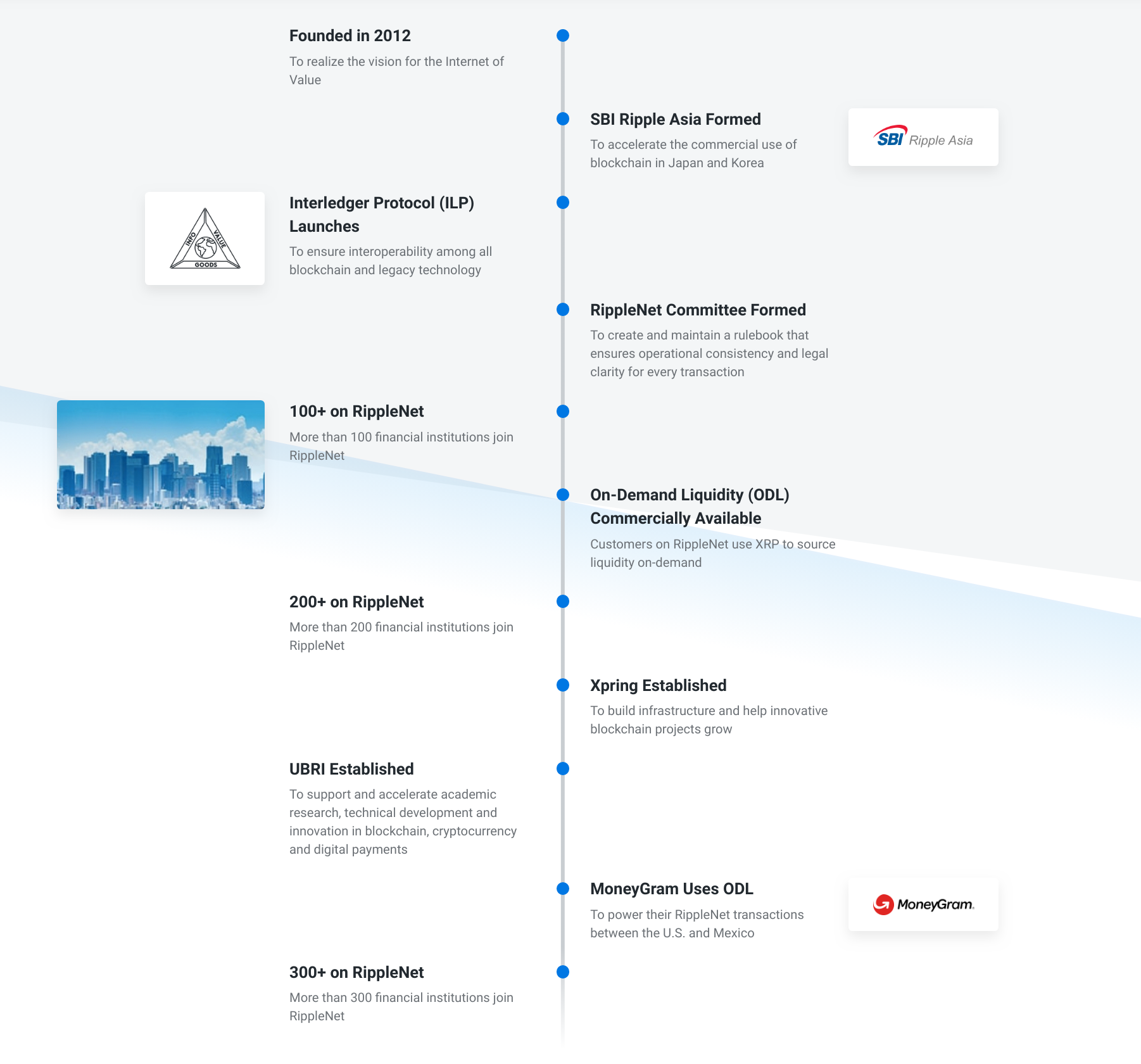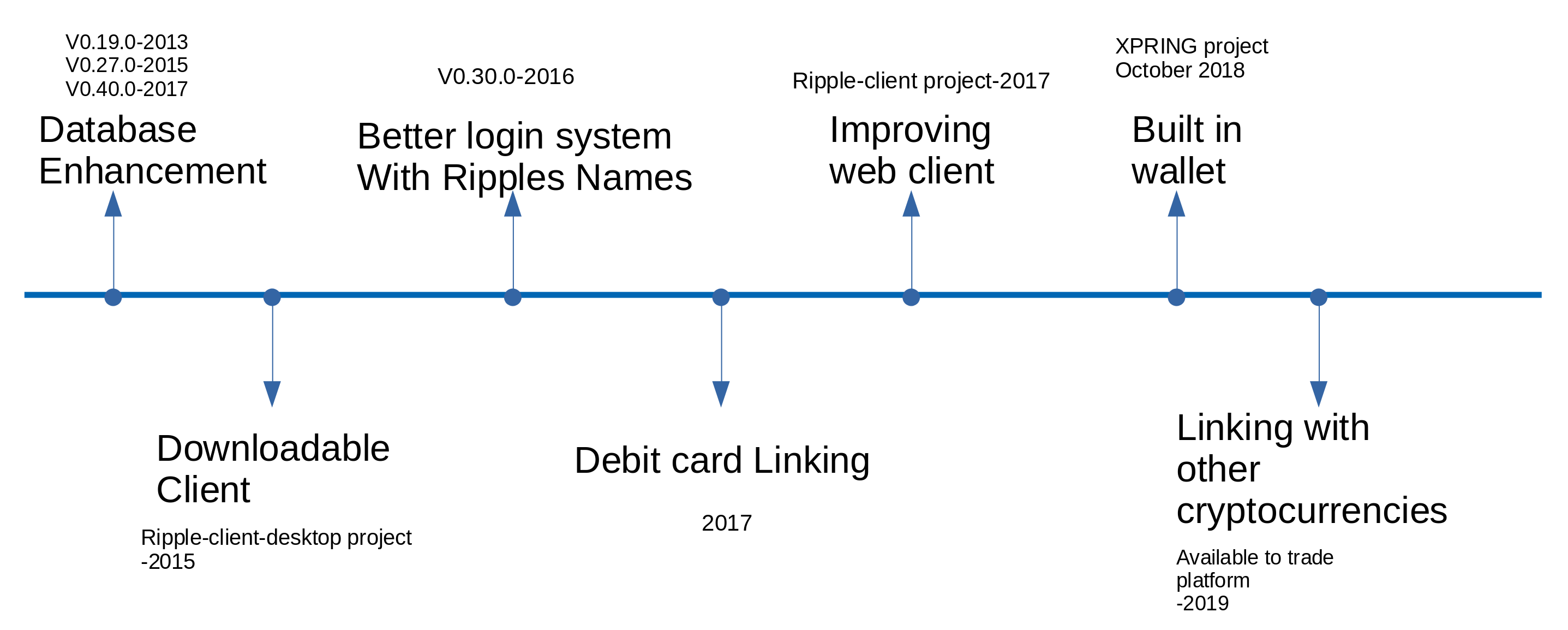The following post examines the Vision and Mission behind the Ripple Team. The essay is carried out by studying the Ripple environment, the stakeholders, and the team’s accomplishments and possible future plans.
An Introduction to Ripple
Ripple is a technology company that provides the most efficient solutions to send money globally using the power of blockchain technology. Ripple’s vision is to enable the world to move value like information moves today—the Internet of Value. Ripple is the only enterprise blockchain company today with products in commercial use. Ripple’s global payments network, RippleNet, includes over 300 financial institutions across 40 countries and six continents. Ripple works with regulators, governments, and central banks—not against them—to improve the way the world moves money.1
This study targets the open-source server software built upon the XRP Ledger, rippled. To begin, first we briefly describe the three notions that are repeated frequently in the survey.
The XRP Ledger is a decentralized cryptographic ledger powered by a network of peer-to-peer servers. The XRP Ledger is the home of XRP, a digital asset designed to bridge the many different currencies in use worldwide. 2
rippled, the open-source server software that powers the XRP Ledger is called rippled and is available under the permissive ISC open-source license. The rippled server is written primarily in C++ and runs on a variety of platforms. 3
and finally, RippleNet, as Ripple puts it, is the ” The world’s most accessible global payments network4.” Ripple solves the needs of individuals and businesses sending cross-border payments through RippleNet, a network of banks, payment providers, and others. RippleNet aims to provide real-time, low-cost, and fully trackable payments on a global scale.5

Figure: diff-ripple-xrp
“To help clarify how Ripple, the technology company, and XRP, the independent digital asset, are distinctly different, we’ve outlined in a simple infographic the most frequently asked questions related to the two”6
Key Features of the XRP Ledger
TODO intro for this part, summerize
- Censorship-Resistant Transaction Processing: No single party decides which transactions succeed or fail, and no one can “roll back” a transaction after it completes. As long as those who choose to participate in the network keep it healthy, they can settle transactions in seconds.
- Fast, Efficient Consensus Algorithm: The XRP Ledger’s consensus algorithm settles transactions in 4 to 5 seconds, processing at a throughput of up to 1500 transactions per second. These properties put XRP at least an order of magnitude ahead of other top digital assets.
- Finite XRP Supply: When the XRP Ledger began, 100 billion XRP were created, and no more XRP will ever be created. The available supply of XRP decreases slowly over time as small amounts are destroyed to pay transaction costs.
- Responsible Software Governance: A team of full-time, world-class developers at Ripple maintain and continually improve the XRP Ledger’s underlying software with contributions from the open-source community. Ripple acts as a steward for the technology and an advocate for its interests, and builds constructive relationships with governments and financial institutions worldwide.
- Secure, Adaptable Cryptography: The XRP Ledger relies on industry standard digital signature systems like ECDSA (the same scheme used by Bitcoin) but also supports modern, efficient algorithms like Ed25519. The extensible nature of the XRP Ledger’s software makes it possible to add and disable algorithms as the state of the art in cryptography advances.
- Modern Features for Smart Contracts: Features like Escrow, Checks, and Payment Channels support cutting-edge financial applications including the Interledger Protocol. This toolbox of advanced features comes with safety features like a process for amending the network and separate checks against invariant constraints.
- On-Ledger Decentralized Exchange: In addition to all the features that make XRP useful on its own, the XRP Ledger also has a fully-functional accounting system for tracking and trading obligations denominated in any way users want, and an exchange built into the protocol. The XRP Ledger can settle long, cross-currency payment paths and exchanges of multiple currencies in atomic transactions, bridging gaps of trust with XRP.
Stakeholder Analysis
People have different interests in the Ripple Project. In this study, Rozanski & Woods’ stakeholder types 7 are used as a guideline to identify the various stakeholders. In the table below, a brief definition of stakeholder types can be found.
| Type | Brief description |
|---|---|
| Acquirers | Oversee the strategy of the product and seek for commercial profits |
| Assessors | Investigate the entire company for compliance with legal matters or industry standards |
| Communicators | Provide information and details of the system for other stakeholders |
| Support Staff | Provide users with technical support and answer potential questions |
| Developers | Develop the software system based on development needs |
| Maintainers | Manage the evolution of the system once it is deployed and operational |
| Testers | Operate the program under specified conditions to find program errors and measure software quality |
| Investors | Legal persons or companies who invest cash to purchase certain assets to obtain benefits or profits |
| Users | Individuals and companies who use Ripple for blockchain business |
| Competitors | Compete for a commercial gain of the same product or in the same industry |
Acquirers
From the analysis of investments, MoneyGram International invests PIPE-IV round with $20M, and SBI Investment and Hinge Capital invest Series B with $55M. It is easy to conclude that the management members of these companies are the acquirers of Ripple. For fintech companies, they sponsor Ripple and need the real-time money transfer and estimation services provided by Ripple. For capital companies, they invest Ripple and gain dividends from stocks.
Assessors
The Financial Crimes Enforcement Network (“FinCEN”) has the authority to investigate money services businesses. This organization assesses legal matters related to Ripple and checks whether Ripple is compliant with the standards for the regulation of a commercial blockchain company. Besides, CryptoNewsZ is a company that makes assessments for crypto markets. Ripple (XRP) is one of the leading bitcoin cases, and there are yearly assessments with its stock price, future trend, and market conditions made by CryptoNewsZ.
Communicators
The Ripple communication system is RippleNet. It enables access to new markets, expands users’ services, and delivers the best customer experience in global payments. Customers can access the blockchain technology for global payments, payout capabilities, On-Demand Liquidity as an alternative to pre-funding, and operational consistency through a common rulebook.
Support Staff
Ripple offers three types of support on the official website. A form to contact the Sales Team, a form to contact the Press Team for press requests and finally, FAQs answering questions about Ripple company, XRP Token, XRP Tech, and Merchandising.
For more technical support, there are other resources, such as the XRP Ledger platform, which is an open-source technology. One can integrate and contribute to the platform using the tools and information provided.
Developers
The most active repositories of the Ripple project are xrpl-dev-portal, XRP Ledger developing documentation, rippled, The source code and, ripple-lib, an API development for interacting with the XRP Ledger. On average, these repositories have more than 70 Contributions. Below some of the leading developers of the project have listed.
| Active Repository | Github ID | Affiliation | Contribution | Role |
|---|---|---|---|---|
| rippled | @JoelKatz | David Schwartz | 4,251 commits | Ripple CTO and network architect |
| @vinniefalco | Vinnie Falco | 2,633 commits | Former Ripple Engineering Manager, President at C++ Alliance | |
| @ahbritto | Arthur Britto | 1,384 commits | ||
| @nbougalis | Nik Bougalis | 589 commits | Ripple Software Engineer | |
| @mellery451 | Michael Ellery | 160 commits | Ripple software generalist | |
| @justmoon | Stefan Thomas | 194 commits | Open-source developer | |
| xrpl-dev-portal | @mDuo13 | Rome Reginelli | 1,806 commits | Ripple Labs Employee |
| @jhaaaa | Rome Reginelli | 100 commits | ||
| ripple-lib | @wltsmrz | 528 commits | ||
| @geertweening | Geert Weening | 262 commits | Ripple Employee | |
| @intelliot | Elliot Lee | 205 commits | Ripple Employee |
David Schwartz is the CTO at Ripple and is one of the original architects of the Ripple consensus network. Vinnie Falco is also one of the leading developers, and he took over David’s work since 2013. The early development of Ripple was from 2012 to 2014, and the subsequent jobs are maintaining and updating.
Maintainers
Depending on the timeline of Ripple’s commitment, different engineers and open-source developers are responsible for Ripple’s maintenance. Since there is no clear description of the division of labor during the program development and operation and maintenance, all the developers above can be seen as maintainers.
Testers
The developers themselves look into the testing procedures. They undergo unit testing on each component of the repository.
Investors
The key investors of Ripple are players such as Andreessen Horowitz, SBI Investment, and more. In angel rounds, the company attracts corporate supporters and famous crypto bulls, including Tim Kendall, the former President of Pinterest, Jesse Powell, Co-founder, and CEO of Kraken exchange and others. In Venture Capital series rounds, specific capital companies and venture companies like SBI Investment and Accenture fund Ripple for commercial usage.
Users
There are hundreds of financial institutions around the world, relying on RippleNet to process their customers’ payments anywhere in the world. Some of the important users are mentioned below.8
- American Express
- MoneyGram
- Santander
- SCB
- SBI Remit
- NIUM
- Banco Rendimento
Case Studies
-
Santander
Customers who were not doing international transfers are now using the service. Customers who were using international transfers are now doing it more. Furthermore, the customers who had gone to use fintech competition have come back because of the One Pay offering.
-
NIUM
Through NIUM’s use of Ripple in the Philippines and Mexico corridors, they have been able to eliminate pre-funding requirements. They offer faster remittances at a lower cost.
-
SBI Remit
They must continuously search for superior technological solutions to deliver ever improved remittance flows. Ripple helps open up new revenue potential for business and a better overall experience for customers.
Competitors
As part of the hype surrounding cryptocurrencies, there is a huge number of competitors for Ripple, including Bitcoin, Dogecoin, Litecoin, Ethereum. Among them, Bitcoin is the most widely used.
Litecoin is a fork version of the bitcoin system that has more features such as:
- a decreased block generation time (2.5 minutes)
- increased maximum number of coins
- different hashing algorithm (script, instead of SHA-256)
- slightly modified GUI
Dogecoin is a further fork of the Litecoin system, which used primarily as a tipping system on Reddit and Twitter to reward the creation or sharing of quality content.
One can see that Ripple faces competitors in high quantity as well as of great quality. Hence, it is ever so important to leverage help from the open-source community and create the best software possible.
Product Context
In this section, the Ripple environment, its connection to external entities, people, and systems are portrayed. The context view diagram represents an overview of the different entities currently associated with Ripple:

Figure: Product context
The most popular users of Ripple are large financial institutions like American Express, MoneyGram, and SBI Remit since Ripple is one of the pioneers in Cryptocurrency. It is also backed by companies such as Standard Chartered and a16z. However, Ripple is in stiff competition against heavy-weight leaders such as Bitcoin and Etherium. They are also in the careful inspection of The FinCEN. RippleNet, a project of Ripple, provides banks and businesses different solutions to transfer money globally. The codebase maintained on GitHub is written in C++ and has support in Linux, macOS, and Windows.
Roadmap
Roadmap offers us a strategic plan that defines a goal and includes the milestones needed to reach it. It also presents what problems Ripple has overcome by reviewing the development history.

Figure: Ripple road map
9The figure above is the company’s commercial road map since founded. Although the protocol as a working prototype was created away back in 2004, the company started in 2012 when Jed McCaleb secured investment for Ripple Labs.10 The chart below shows the additional functions the developers introduced to the ripple core.

Figure: Software Roadmap
-
https://ripple.com/faq ↩
-
https://xrpl.org/xrp-ledger-overview.html ↩
-
https://github.com/ripple/rippled ↩
-
https://ripple.com/ripplenet ↩
-
https://ripple.com/files/ripplenet_brochure.pdf ↩
-
https://ripple.com/insights/difference-ripple-xrp/? ↩
-
https://www.viewpoints-and-perspectives.info/home/stakeholders/ ↩
-
https://ripple.com/customers ↩
-
https://ripple.com/company ↩
-
https://capital.com/ripple-xrp-price-prediction-2020 ↩